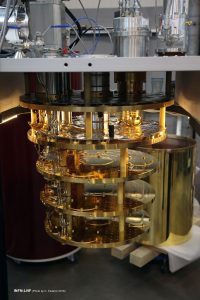 The QUAX (QUest for AXions) experiment looks for the presence in our galaxy of hypothetical particles called axions which could constitute the dark matter. Axions were initially theorized to solve a problem known as “Strong-CP problem”.
The QUAX (QUest for AXions) experiment looks for the presence in our galaxy of hypothetical particles called axions which could constitute the dark matter. Axions were initially theorized to solve a problem known as “Strong-CP problem”.
QUAX uses a particular type of detector called Haloscope designed by P. Sikivie. It consists of a resonant radiofrequency cavity cooled to a temperature close to absolute zero and immersed in a strong magnetic field. The presence of axions in the galaxy would cause a radiofrequency signal detectable with very sensitive and very low noise amplifiers. QUAX also uses a variant of the Haloscope, called “Ferromagnetic Haloscope”, where the ferromagnetic material is placed inside the resonant cavity.
The INFN Division of Padua, Salerno Associated Group and the two National Laboratories of Frascati (LNF) and Legnaro (LNL) participate in QUAX. The first Haloscope was put into operation at LNL and a second is in preparation for the LNF.
QUAX
Latest modified:
16 March 2020
 INFN-LNF Laboratori Nazionali di Frascati
INFN-LNF Laboratori Nazionali di Frascati